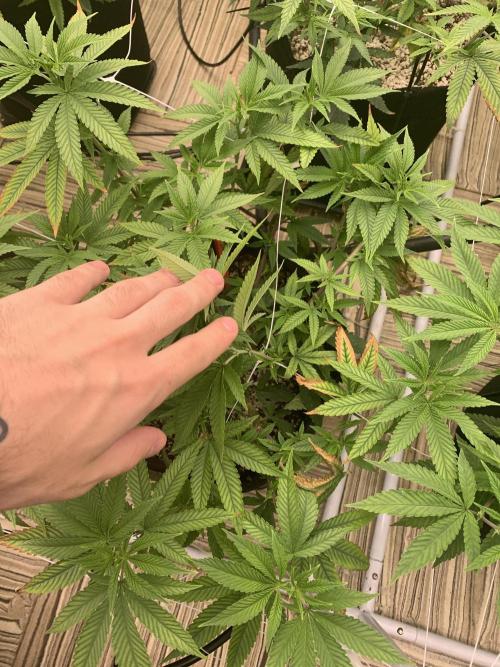The Grow Awards 2026 🏆
problems with brown leaves and yellow
00110001001001111Oanswered grow question 4mo ago
even k-deficiency is possible...
unfortunately, leaf symptoms are not discrete. You need more information to confidently diagnose than just visible leaf symptoms.
likes
Complain
00110001001001111Oanswered grow question 4mo ago
Third picture looks reddish... are the temps dropping below 68F at night? If nights are cold, could be fucking with chemistry of biological processes. If this is the case, tweaks to nutrients may not matter.
p-tox or s-tox are possible, but there's some odd symptoms that don't quite fit either of those issues. So nutrient balance (lockout) or pH (lockout) come into question too. Eliminate possibilities as best you can before choosing to add or dilute anything from medium.
likes
Complain
Hightai90answered grow question 4mo ago
Trim the bad leaves Feed Cal Mag by foliar spray only One time and give It only water that week
likes
Complain
Ultravioletanswered grow question 4mo ago
Last feeding raised EC to its limit, tips start to brown, osmotic stress, the first thing to be affected is calcium uptake. Calcium deficiency can cause interveinal chlorosis, given its immobile it presents new growth primarily. While magnesium deficiency can also cause interveinal chlorosis, it typically appears first in older leaves.
When a pH skews, it's doesn't necessarily mean that there is a deficiency in the medium, its more that thee plant is unable to uptake specifically charged nutrients, When the pH of soil skews alkaline (above 7), phosphorus and several micronutrients, including iron, manganese, zinc, and copper, become less available to plants. This is because high pH causes these nutrients to become insoluble and precipitate out of the soil solution, effectively "locking" them away from plant roots.
Limee greening all over with no obvious starting point is normally an indicator of high pH.
EC think of it like a salt capacity for your medium. Its full leech till its empty. 0.3ms/cm - 1.6ms/cm
PH Gives an idea of the balance of charge + & - of nutrient composition in medium.
If it's organic nitrogen, then its pH is probably acidic
If you feed organic nitrogen, it could be a potential cause, as the plant needs less and less nitrogen as it gets closer to flowering. The organic nitrogen will continue to be broken down to NH4+, as the pH skew, nitrification will slow.
Cations are positively charged ions, and several essential plant nutrients exist in this form. The major cation nutrients plants utilize include potassium (K+), calcium (Ca2+), magnesium (Mg2+), and ammonium (NH4+).
Need an accurate PH first, would really help to know what you have been feeding her, once we know that, it would narrow down solutions a lot.
glcuk
likes
Complain
yan420answered grow question 4mo ago
Hard to say 100% without a diary or more details, but from the pics, looks like they’re showing signs of magnesium deficiency, maybe early phosphorus stress too.
The yellowing between veins on older leaves
looks like a Mg issue
The purpling and darker blotches is a possible P deficiency
Burnt tips could be early K stress or salt buildup
Could be pH drift, underfeeding, or just hitting that stage where they need more support.
Add cal-mag if you’re not already using it
Check your watering pH — aim for 6.2–6.5 in soil, 5.8–6.2 in coco
Boost your feed slightly if you're in mid-veg or early flower
Trim the worst leaves so they can focus on healthy growth. Not critical yet, but they’re asking for help, better to act now.
🤞🍀♥️
3 likes
Complain
Gnrlymsntrp81answered grow question 4mo ago
Hy,
your PH seems to be off and or your nitrogen and calcium levels are too high so your plant can not take up potassium. That's why your leafes look like that and the buds will not develop properly. Check run off (should not exceed 6,5) pH and adjust it with flushing with half nutrient solution.
Much success
1 like
Complain









